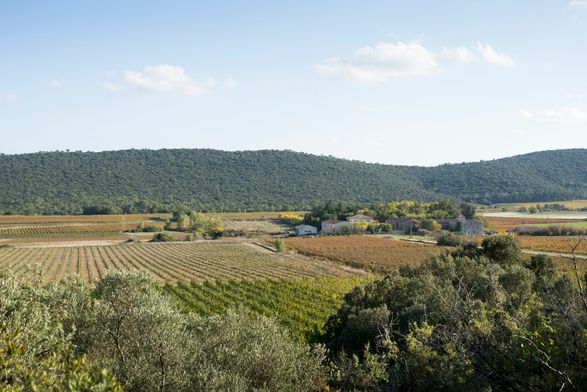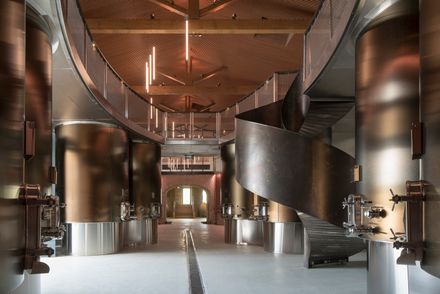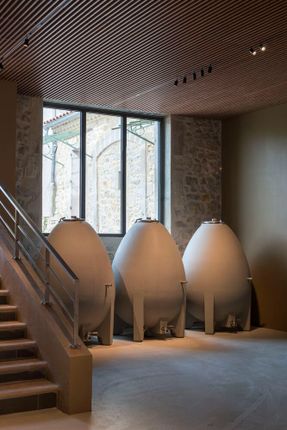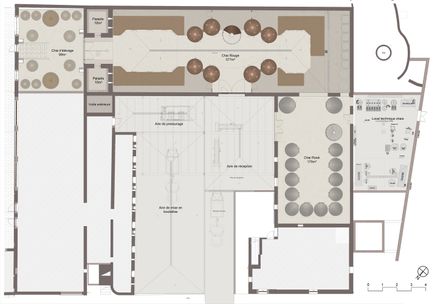Domaine UMA Winery
Domaine UMA Winery
Agence Clausel-Borel Architecte

PROJECT MANAGEMENT ASSISTANCE
Moubarek Berkouk
PROCESS ENGENEERING
Iprocess
DESIGN OFFICE
Agence Clausel-borel
BET THERMAL
Bet Durand
PROJECT OWNER
Domaine Uma
YEAR
2023
LOCATION
Valflaunès, France
CATEGORY
Industrial Architecture, Winery
IN THE HEART OF THE "PIC SAINT LOUP" PROTECTED DESIGNATION OF ORIGIN LANDS
The Domaine UMA has an exceptional setting, with vineyards and garrigue as far as the eye can see, facing the Hortus and Pic Saint-Loup mountains, the Château de Montferrand and the Chapelle d'Aleyrac, the former quarry from which the Domaine's stone comes.
A place bathed in shimmering, ever-changing light, each time revealing the landscape from a new angle. Add to this the different seasons and colors, and you have an enchanting, yet different view every time.
So, when you arrive at the Domaine, you enter a timeless place, far from the hustle and bustle of the city, surrounded by this magnificent landscape.
The Domaine's simple, solid-stone buildings are typical of the region and similar to those found in the Cévennes. Its imposing scale reflects the original use of the site, as a former silkworm farm built at the end of the 19th century.
The double-U floor plan opens onto two wind-protected courtyards. Transformed and divided into two wineries over the course of its history, Domaine Uma is today the result of the merger of two ancestral vineyards: Château Cambon and Domaine de Valcyre.
THE CELLAR, THE DOMAIN'S DEN
In a winery, the cellar represents the heart, the raison d'être of the Domaine, its den. Located in the second "U" of the building, it is entered from a mineral courtyard adapted for receiving the harvest and bottling the wine.
A large door, oblong at the edges, symbolizes the entrance, but for the rest, the winery's interior is not visible from the outside.
The latter, located in the existing building, is not ostentatious; there is no architectural gesture here, but rather a desire for timelessness. Entering the winery is like entering a cave, a timeless place with a sacred character.
Our architectural aim was to recapture the majesty and authenticity of the site, by renovating all the walls that had been rendered in concrete and revealing the original stonework of this 200-year-old building. This approach is in keeping with the organic, lucid way in which wine is produced here.
ARCHITECTURAL INTENTIONS, THE WINERY AS A SCENIC SPACE
We wanted to create an almost scenographic experience, where the winery, while meeting its technical needs, is also a space for staging the preparation of wine.
The spiral staircase, located opposite the entrance to the cellar, is laid out like a sculpture, creating a link between the stage on the first floor and the walkways.
Around this central staircase, we placed the tanks in a double curve to create expanding spaces where the stainless steel and concrete tanks would stand out like totems.
The walkways, resting on the tanks, whose primary purpose is to recreate gravity and thus eliminate the need for pumps, create spaces offering a different viewpoint, and give the space vertical and horizontal rhythm.
In keeping with this theatrical spirit, two glassed-in dressing rooms on either side of the volume on the first floor offer a completely different view of the cellar, a veritable control room for the oenologist who will be working there, and a wine-tasting area on the other.
This suspended room, a veritable showcase dedicated to wine tasting, offers its clientele both the spectacle of the winery and a kinetic framing through a large arched opening onto the Pic Saint Loup and the Hortus.
As an extension of this space, outside, the Terrasse du Pic offers a glimpse of the exceptional setting of the site.
Back on the lower level, a visual breakthrough leads from the vinification cellar to the former cellar, now the aging cellar.
In this temperate space, tuns and ovoid concrete vats coexist, offering a completely different approach to the work of transforming wine.
Between these two production sites, almost hidden in their stone chapels, the paradises house Domaine's most precious bottles.
The technical areas, the backstage areas of the winery, are concealed behind the self-cooling vats of the vinification cellar and house the many tools required for the winemaking process.
LIGHTING AND POLYCHROMY BETWEEN TECHNIQUE AND SCENOGRAPHY
The polychromatic ambiance is warm and natural, with stone, wood and stainless-steel vats in shades of copper, brown and corten blending with stainless steel, the technical material characteristic of a winery.
The lighting inside the winery emphasizes the architectural envelope and the richness of the materials.
Each mode nature of the space is emphasized: the stone walls, the wood cladding on the underside of the roof, the trusses, the stainless steel and concrete tanks.
Low-angled lighting, set in grooves in the side walls, accentuates the perspective from the tasting room to the laboratory, focusing visitors' gaze on the origin of the winemaking process.
This focusing effect is accompanied by a light sculpture composed of suspended lines, forming an evanescent undulation from the central staircase toward the laboratory.
Several color variations punctuate the different temporalities of the winery: from technical lighting to colorful decorative lighting that sets the scene for the space.
To sum up, our aim was to restore the majesty and authenticity of this existing space, to reveal it and to give a sense of timelessness to this 200-year-old building dedicated to wine-making.



































